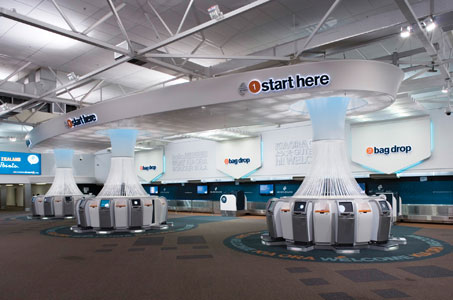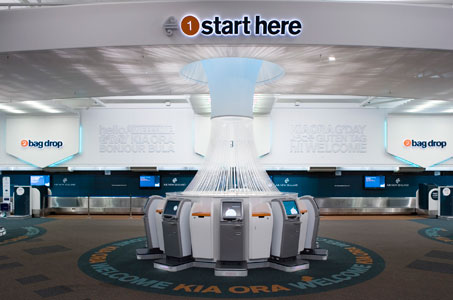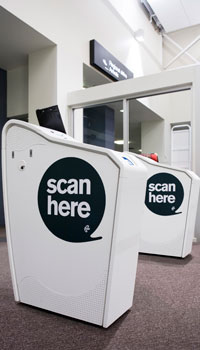
The Air New Zealand experience is that check-in is becoming increasingly irrelevant to the customer. As the airline’s customers are now able to receive their boarding passes at time of purchase, or through their mobile devices, or as they are actually boarding the aircraft, the need for the customer to check-in has effectively been removed. As a result, Air New Zealand is focusing more of its attention on passengers traveling with a bag and how their journey can be simplified. While Air New Zealand has made some significant advancement with self tagging and bag drop, it has opened up a range of new opportunities to improve the experience for customers getting their bag to the airline and managing the journey of the bag. “I believe that most airlines should be past the stage of thinking about if they need a self-service strategy, but rather how they go about designing and implementing one,” said Todd Grace, Strategy Manager – Airports, Air New Zealand. “I hope to be able to share some of the innovations we have developed, the lessons we have learnt, as well as the benefits we are seeing from changing our business model.”
The airline’s experience to date is that customers are extremely capable and want to manage their own travel. If offered a solution that is intuitive and provides travelers with benefits in both time and choice, then they will embrace the new service and quickly migrate away from traditional travel patterns. He believes that it is, therefore, important that the solution is customer-centric and focuses on providing value to the customer. “It is not simply a technology solution. It requires an airline to review the operational procedures that support all airport activity,” explained Grace. “Within a few months we quickly began to see the other benefits that flowed from a successful self-service strategy. In addition to the benefits brought by having increased customer satisfaction, we saw more productive use of terminal space, greater efficiencies in resource allocation and planning, greater engagement by airport staff, as well as a positive effect on brand awareness for the airline.”
Pure self-service experience

Air New Zealand has varying degrees of automation at its airports, but at the domestic terminal in Auckland it has been able to offer the most pure self-service experience. This is due to it being the gateway for travel within New Zealand, so all of the customers are making domestic journeys. “At Auckland many customers without baggage choose to bypass check-in and just board the aircraft. For those customers with baggage, the kiosk solution allows them to change a flight if they wish, check-in, change seats, pay for any excess baggage, and print their bag tags. Once the customer has tagged their bag, they simply place it on a baggage belt and the bag is sent airside,” said Grace. “While the bag is on the baggage belt we carry out a number of security and operational processes so that by the time the bag reaches the baggage loaders, it is ready for acceptance onto the aircraft. This is all carried out without the intervention of any staff, however, they are always available for any assistance or troubleshooting.”

The proportion of Air New Zealand’s passengers using self-service check-in is increasing. Following the launch of its domestic product, the airline reached its 80% self-service target three days after going live. That has continued to grow to the stage that the number of full-service customers traveling within its domestic network has reduced to a trickle. “While kiosk check-in is responsible for managing the majority of our customer journeys, we are seeing an increasing number of customers bypass the kiosks altogether and head straight to the aircraft,” explained Grace. “When we launched kiosk check-in from Auckland to all of our Australian destinations, we saw a similar growth in uptake. It has reinforced our view that it is a product that provides a level of service that is valued by our customers and gives us the confidence to continue our deployment program.”
When designing its current airport experience, Air New Zealand’s goal was that the customer journey should be as simple as most other forms of public transport. It has gone a long way towards achieving that with its domestic network. “On our international routes we still face some significant challenges. When traveling across border, the requirement for customers to provide their personal data to multiple governmental agencies throughout their journey is both time-consuming and inefficient for everyone involved. Airlines, airports and border agencies need to work together to make for a streamlined process for the customer to easily pass through the border,” said Grace. “The future experience also needs to be designed with the focus on providing the consumer with greater choice. Options for bag drop in convenient accessible locations, not dictated by the needs of the airline or the airport, but rather in the location where the customer would most value them.”
The need for all operators in the airport community to jointly develop processes and be able to share data on a common platform is key to achieving the next step change in the airport journey. The development of RFID, mobile and biometric technologies has enabled a vast range of innovative solutions to be developed for our customers. “We are seeing a lot of that innovation coming from airlines, as well as some airports and border agencies. The risk we face is that this is done in isolation and the optimum solution for the customer is not realized,” concluded Grace.
 Hear more from Todd Grace, Strategy Manager – Airports, Air New Zealand, at Check-in 2010, taking place at the MGM Grand Hotel Conference Center, Las Vegas, September 8-10 and also at the inaugural Check-in Asia event being held in Kuala Lumpur, November 24-26.
Hear more from Todd Grace, Strategy Manager – Airports, Air New Zealand, at Check-in 2010, taking place at the MGM Grand Hotel Conference Center, Las Vegas, September 8-10 and also at the inaugural Check-in Asia event being held in Kuala Lumpur, November 24-26.





